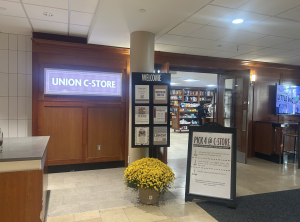Artist talk unpacks Latinx identity for a new generation
February 11, 2019
All art has source material outside its immediate subject. Sometimes that material is a universal human experience with love or nature, but other times it’s the legacy of colonialism in the twenty-first century.
For artists Pablo Helguera and Martine Gutierrez, it was the latter that informed their creative process and caused them to embark on quests to interrogate dominant historical narratives and explore Latinx identity in new ways.
Their final visions are included in a larger exhibit titled, “A Decolonial Atlas: Strategies in Contemporary Art of the Americas,” which is currently on display in Union College’s Mandeville Gallery.
On January 31, Helguera and Gutierrez visited Union to discuss their work and its roots. What followed was a candid exchange of ideas, moderated by exhibition curator Pilar Tompkins Rivas, about the meanings of marginalization and reclamation as they relate to our collective artistic memory.
Multimedia artist Pablo Helguera’s journey is an impressive one. He began by telling the audience that his inspiration came from disillusionment after September 11, 2001, a feeling that only grew in strength as the United States engineered increasingly destructive foreign policy.
At the advent of the Iraq War, he knew he had to put his frustrations to work in his art. Thus was born the School of Panamerican Unrest, a project that took Helguera across the Americas, leading workshops where he invited participants to write a speech to the world about their town.
In this way, he created a revolutionary platform that went beyond the conventional museum and gallery contexts.
The people in most need of empowerment — those living in the “backwater of the universe” — are those least likely to have access to the haute realm of art exhibits, he explained: “[I see myself as] a carpenter of a particular receptacle where people can put their information… my job was to create this container where people were comfortable sharing what they knew, and I was helping them to know what they know.”
But in traveling far and wide to capture the multitude of Latinx experiences, Helguera realized that there was one voice he failed to capture — his own. This dissonance led him to pursue a new mission, one that produced his eventual contribution to A Decolonial Atlas.
He followed the same framework of exploring identity, but widened his scope, using National Geographic photographs of Latinx life — or rather, what national mainstream media and its influences thought that life looked like — to create collages.
What makes this body of work so unique is that Helguera’s voice is informed by his own experiences as well as the hundreds of people from whom he’s heard over the years.
The collages, aside from being visually striking, provide insightful commentary on the disparity between colonial expectations and the lived reality of marginalized people. They rearrange traditional narratives in every sense of the word.
Photographer and performance artist Martine Gutierrez is also invested in exploring new ideas of Latinx self-determination and self-preservation, but her work is perhaps a different manifestation of the discovery process.
Where Helguera’s voice is implicit in his art, Gutierrez makes herself the explicit subject, positioning herself in front of the camera as she works through restrictive stereotypes and binaries in real time. The only other parties in her photographs are mannequins, extensions of the self that emphasize the contradictions of personhood on conventional terms.
The result is a deeply personal connection with herself and with the viewer.
The goal, she said, is to “replace this cis[gender], white, blue-eyed person in these platforms, and in place putting me… positioning my body in this way, I have full autonomy over my image. I can say what I want to say…no one else could make [this] except me.”
The celebration of one’s own body is controversial when people disagree with your right to exist in the first place.
She noted that in a room like the one in which they spoke in that moment, it was useless to talk about base concepts of equality. But in more polarized landscapes, she finds liberation in the tension: “Please keep staring,” she wants to say to them, “please get it wrong.”
Both artists demonstrated a comprehensive understanding and a deep passion for what they see as the infiltration of a collective identity, that is, the concept of life in the Americas that relies on colonial structures and prejudices.
Their pieces stand as compelling personal projects and as contributions to the larger effort to decolonize imagery in academia and art alike, a movement that grows stronger with every story that enters the fold.
Helguera’s and Gutierrez’s work is on display in the Mandeville Gallery on the second floor of the Nott Memorial for the remainder of this term.






